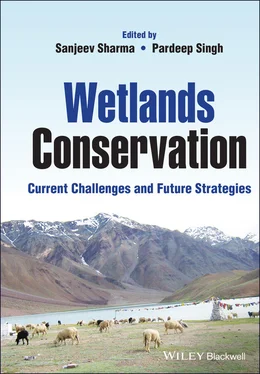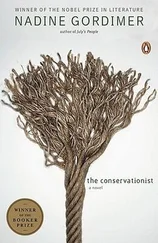Wetlands Conservation
Здесь есть возможность читать онлайн «Wetlands Conservation» — ознакомительный отрывок электронной книги совершенно бесплатно, а после прочтения отрывка купить полную версию. В некоторых случаях можно слушать аудио, скачать через торрент в формате fb2 и присутствует краткое содержание. Жанр: unrecognised, на английском языке. Описание произведения, (предисловие) а так же отзывы посетителей доступны на портале библиотеки ЛибКат.
- Название:Wetlands Conservation
- Автор:
- Жанр:
- Год:неизвестен
- ISBN:нет данных
- Рейтинг книги:3 / 5. Голосов: 1
-
Избранное:Добавить в избранное
- Отзывы:
-
Ваша оценка:
- 60
- 1
- 2
- 3
- 4
- 5
Wetlands Conservation: краткое содержание, описание и аннотация
Предлагаем к чтению аннотацию, описание, краткое содержание или предисловие (зависит от того, что написал сам автор книги «Wetlands Conservation»). Если вы не нашли необходимую информацию о книге — напишите в комментариях, мы постараемся отыскать её.
An up-to-date overview of approaches for addressing wetlands degradation and its effects on ecosystem services, human health, and other ecosystems Wetlands Conservation: Current Challenges and Future Strategies
Wetlands Conservation: Current Challenges and Future Strategies
Wetlands Conservation — читать онлайн ознакомительный отрывок
Ниже представлен текст книги, разбитый по страницам. Система сохранения места последней прочитанной страницы, позволяет с удобством читать онлайн бесплатно книгу «Wetlands Conservation», без необходимости каждый раз заново искать на чём Вы остановились. Поставьте закладку, и сможете в любой момент перейти на страницу, на которой закончили чтение.
Интервал:
Закладка:
Editorial Office 9600 Garsington Road, Oxford, OX4 2DQ, UK
For details of our global editorial offices, customer services, and more information about Wiley products visit us at www.wiley.com.
Wiley also publishes its books in a variety of electronic formats and by print‐on‐demand. Some content that appears in standard print versions of this book may not be available in other formats.
Limit of Liability/Disclaimer of Warranty The contents of this work are intended to further general scientific research, understanding, and discussion only and are not intended and should not be relied upon as recommending or promoting scientific method, diagnosis, or treatment by physicians for any particular patient. In view of ongoing research, equipment modifications, changes in governmental regulations, and the constant flow of information relating to the use of medicines, equipment, and devices, the reader is urged to review and evaluate the information provided in the package insert or instructions for each medicine, equipment, or device for, among other things, any changes in the instructions or indication of usage and for added warnings and precautions. While the publisher and authors have used their best efforts in preparing this work, they make no representations or warranties with respect to the accuracy or completeness of the contents of this work and specifically disclaim all warranties, including without limitation any implied warranties of merchantability or fitness for a particular purpose. No warranty may be created or extended by sales representatives, written sales materials or promotional statements for this work. The fact that an organization, website, or product is referred to in this work as a citation and/or potential source of further information does not mean that the publisher and authors endorse the information or services the organization, website, or product may provide or recommendations it may make. This work is sold with the understanding that the publisher is not engaged in rendering professional services. The advice and strategies contained herein may not be suitable for your situation. You should consult with a specialist where appropriate. Further, readers should be aware that websites listed in this work may have changed or disappeared between when this work was written and when it is read. Neither the publisher nor authors shall be liable for any loss of profit or any other commercial damages, including but not limited to special, incidental, consequential, or other damages.
Library of Congress Cataloging‐in‐Publication Data
Names: Sharma, Sanjeev (Assistant professor in environmental sciences), editor. | Singh, Pardeep, editor.
Title: Wetlands conservation : Current challenges and future strategies / edited by Sanjeev Sharma, Pardeep Singh.
Description: Hoboken, NJ : Wiley‐Blackwell, 2022.
Identifiers: LCCN 2021008931 (print) | LCCN 2021008932 (ebook) | ISBN 9781119692683 (hardback) | ISBN 9781119692669 (adobe pdf) | ISBN 9781119696322 (epub)
Subjects: LCSH: Wetlands conservation.
Classification: LCC QH75 .W4656 2022 (print) | LCC QH75 (ebook) | DDC 333.91/8–dc23
LC record available at https://lccn.loc.gov/2021008931LC ebook record available at https://lccn.loc.gov/2021008932
Cover Design: Wiley
Photograph: Chandertal Lake, Ramsar Wetland located in Lahaul‐Spiti District, Himachal Pradesh‐India
Photo Credit: Sanjeev Sharma
Preface
Wetlands are critical natural resources and most productive ecosystems on earth. They are rich in terrestrial as well as aquatic flora and fauna. Wetlands hold significance for biodiversity, water conservation and ecosystem services. The critical ecosystems of wetlands support livelihoods and form a lifeline for billions of people living within wetlands and in their periphery. Majority of the global population is directly and indirectly dependent on these wetlands for drinking water, irrigation and other essential natural ecosystem services. Wetlands are known to provide habitats to as much as 20% of the planet’s various life forms. Wetlands form habitats for endangered and threatened species of wildlife, aquatic flora and fauna. The wetlands are also feeding, breeding and resting areas for a host of migratory birds which travel vast distances over many continents and across different geographical zones and biomes. Wetlands are referred to as biological supermarkets and ‘kidneys and lungs of the landscapes where they exist’ due to their ecological interface with the hydrological, chemical and biological cycles.
Many wetlands are a direct source of drinking water and many rivers also originate from wetlands. Wetlands have supported human existence since antiquity. The nomadic populations across the globe have settled nearby these wetlands since ancient times as wetlands provided ample pastures for livestock rearing. Wetlands have social, economic and cultural significance for human beings. For example, in the Himalayan region of India wetlands have socio‐religious and cultural importance for the inhabitants. People of these regions worship the wetlands and consider these water bodies as sacred. Since 1900, around half of the world’s wetlands have disappeared due to exploitation of natural resources by human beings in the wetlands. Intense human activities in the wetlands have led to degradation and loss of these areas. In addition to anthropogenic pressures, climate change, land use patterns, land cover change, urbanisation, global warming modern agricultural practices etc. have affected the wetland system adversely, across the globe. Preservation and restoration of wetlands will help to conserve these bodies and will also lead to upholding the social, cultural, economic and religious significance of the wetlands. Wetlands hold immense significance in controlling and mitigating floods. For example mangrove wetlands reduce wave energy and thus protect coastal communities from floods etc. Through the process of nitrogen recycling, these wetlands help in improving the downstream water quality. They also help in climate change mitigation and adaptation.
All through in the twentieth century wetlands have faced neglect and disregard. The significance of these wetlands ecosystems were realised by people after second half of the twentieth century onwards and across the globe consciousness rose about the consequences of losing these valuable natural resources. 1971, a Convention on Wetlands called the Ramsar Convention was held in Ramsar, Iran for the conservation and sustainable use of wetlands. This Convention upholds the distinction of being the first modern treaty between countries aimed at conserving natural resources. This Convention necessitated signatories to draft policies for wetland conservation and their wise use. Following the Ramsar Convention on Wetlands, a number of policy instruments were formulated for the protection and conservation of these resources at regional, local and global levels. Though a legal and policy framework is existing on the wetlands, still these resources are not adequately conserved and managed and a large number of wetlands continue to be in deplorable state.
Many governments and different NGO’s are working for wetlands conservation at the local, global and regional level. Some of the International organisations working for conversation and protection of the wetlands include Wetlands International, Ramsar Convention Bureau, WWF, Wildfoul & Wetlands Trust, US Fish and Wildlife Services, The Wetlands Institute, The Wetlands Initiative, Society of Wetlands Scientist, IUCN, Birdlife International and many state and national wetland authorities.
This book aims at elucidating both policy and management practices for wetland managers and indigenous technical knowledge for the management of wetlands. This book contains 13 chapters representing different geographical regions ranging from the coastal regions to high altitude Eastern and Western Indian Himalayas. Different types of studies on wetlands such as those of coastal, mangroves, lagoon, reservoir‐based wetlands and high‐altitude wetlands studies from are highlighted in this book. This book provides baseline information on wetlands, along with definition, categorization, classification and global status of wetlands as well conservation policies. The Ramsar Convention, legal frameworks and effectiveness of the instruments of the Convention are also highlighted in the book. It also describes the different tools and methods used for recognition of economic evaluation of wetlands. Case studies from Eastern Himalayan, Western Himalayan, plains of India and coastal regions in this edited book provide an in‐depth understanding of these diverse ecosystems, along with their current status, challenges and future strategies for conservation. People’s participation and action learning through multidisciplinary and holistic approaches for wetland conservation and restoration are also suggested in the book. In addition the book also attempts to highlight sustainable practices for conservation of wetlands ecosystems along with the development of national plans and research for their conservation. Various initiatives have been carried out by different bodies for conservation of wetlands, but a significant reason for the failure of conservation initiatives is lack of accurate scientific information on wetlands. Thus, science based participatory conservation actions have been strongly advocated in the book. It is recommended in the book that genuine research be conducted, which can lead to desirable policy interventions. This book cover insightful scientific and socio‐cultural aspects related to the wetlands. It is aimed that this book will be a useful resource for researchers, ecologists, geographers, policymakers and other stakeholders working on the natural resources, wetland and water management.
Читать дальшеИнтервал:
Закладка:
Похожие книги на «Wetlands Conservation»
Представляем Вашему вниманию похожие книги на «Wetlands Conservation» списком для выбора. Мы отобрали схожую по названию и смыслу литературу в надежде предоставить читателям больше вариантов отыскать новые, интересные, ещё непрочитанные произведения.
Обсуждение, отзывы о книге «Wetlands Conservation» и просто собственные мнения читателей. Оставьте ваши комментарии, напишите, что Вы думаете о произведении, его смысле или главных героях. Укажите что конкретно понравилось, а что нет, и почему Вы так считаете.










